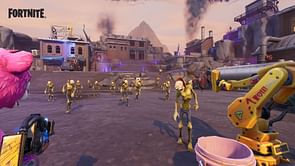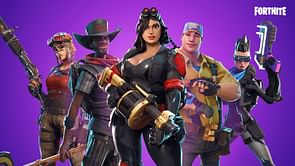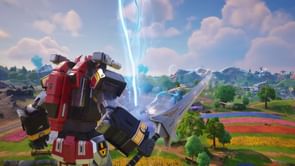
Fortnite: Save the World is a collaborative third-person shooter tower defense survival game set in a sandbox environment. It was created and published by Epic Games as a component of the larger Fortnite game. Initially, it was released as a paid early access title on July 25, 2017, for Microsoft Windows, macOS, PlayStation 4, and Xbox One. Epic Games had plans to eventually transition it into a free-to-play game, but in June 2020, they decided to make it a pay-to-play experience instead. The retail versions of the game were published by Gearbox Software, while Epic's launcher handles the online distribution of the PC versions.
The storyline of Fortnite takes place on a contemporary Earth where a global storm suddenly emerges, causing 98% of the world's population to vanish, while zombie-like creatures appear and attack the remaining survivors. Epic Games describes Fortnite as a combination of Minecraft and Left 4 Dead. Up to four players can work together in missions across different maps, collecting resources, building fortifications to defend objectives against the storm, protecting survivors, and crafting weapons and traps to combat waves of creatures aiming to destroy the objectives. Completing these missions rewards players, allowing them to enhance their hero characters, support teams, and an arsenal of weapon and trap schematics, enabling them to take on more challenging missions.
Initially, microtransactions were utilized in Fortnite: Save the World to purchase in-game loot boxes that could contribute to these upgrades. However, Epic Games introduced a separate battle royale version called Fortnite Battle Royale in September 2017. With this change, they discontinued the use of loot boxes and instead offered cosmetics for direct purchase using an in-game currency known as V-bucks. In conjunction with this alteration, the player-versus-environment mode was officially designated as Save the World.
Synopsis
In an unforeseen event, 98% of the Earth's human population vanished overnight, leaving behind a bleak world where dense clouds dominated the skies and tumultuous storms unleashed husks upon the remaining survivors. These husks, humanoid zombie-like creatures, posed a constant threat as they relentlessly attacked the living. Amidst this chaos, the resilient survivors devised a means to create storm shields - protective barriers that cleared the immediate airspace of storm clouds and mitigated husk assaults. With these shields in place, they established bases scattered worldwide, serving as havens for the survivors.
As a player, you assume the role of a commander entrusted with the responsibility of managing one of these bases. Your mission is to venture beyond the safety of the storm shield, exploring the hazardous surroundings to gather vital resources, locate fellow survivors, and forge alliances to fortify your storm shield further. Your ultimate objective is to find a way to restore Earth to its former state, free from the grip of chaos, and reclaim its normality.
Gameplay
The gameplay in Fortnite: Save the World revolves around defending the storm shield against hordes of zombie-like creatures, incorporating elements of tower defense. The game offers three distinct gameplay modes: Fortnite Battle Royale and Fortnite Creative, which are separate free-to-play titles, and the cooperative player-versus-environment mode, "Save the World," which is exclusive to the main Fortnite game and requires payment.
In Fortnite: Save the World, players embark on quests and participate in events. The game is a unique combination of sandbox survival, cooperative gameplay, lite RPG elements, tower defense mechanics, and exploration. It involves progressing as a player, exploring the game world, scavenging for items, sharing limited resources, crafting weapons, constructing fortified structures, and battling waves of encroaching monsters. Epic Games founder, Tim Sweeney, described it as a fusion of Minecraft meets Left 4 Dead. The gameplay perspective is third-person, alternating between managing resources at a secure home base and going on missions to complete quests, gather resources, and earn rewards that advance the game's story.
Players can track their story progress and quests, including daily, weekly, side, challenge, and event quests. Completion of these quests grants in-game currency or resources.
Fortnite: Save the World also features themed events that introduce unique progression paths, new locations, and rewards aligned with the event's theme. One example is the Halloween event called Fortnitemares, which offered Halloween-themed heroes, characters, weapons, and traps. These event items could be used beyond the event itself by fulfilling various objectives.
Maps and Missions

The game features various missions that are spread across four different world locations. Some of these locations are only accessible after progressing sufficiently in the story, while others are specific to timed events or the Survive the Storm mode. Within each location, players can find different mission areas that indicate the mission type, terrain, difficulty level relative to the player's power, and whether the mission is affected by special storm conditions. These storm conditions introduce random effects, such as stronger husks or mini-bosses, but offer better rewards if successfully completed. Players can choose to play with others and have the option to join forces with players of similar power and story progression, increasing the rewards for everyone involved.
During missions, players have the ability to construct fortifications using three different base materials: wood, brick, and metal. These materials can be used to create floors/ceilings, walls, stairs, ramps, and more. Players can also edit these structures to add doors or windows. Fortifications can be upgraded using additional resources of the same type to enhance their durability. If fortifications are damaged, players can repair them by spending additional resources. To deter husks, players can strategically place traps on floors, walls, and ceilings. Traps have a limited number of uses before they break but can be designed to be more lethal or effective against husks. Some traps offer beneficial resources, such as healing pads, defender posts, and launch pads. In addition to fortifications and traps, players have access to a range of weapons, but these weapons have limited durability that decreases as they are used or as a penalty if the player is incapacitated by husks and needs to respawn without assistance. Players can craft new weapons, ammunition, and traps using gathered resources or find them by searching containers scattered throughout the map. The game also features an accelerated day-night cycle during missions, with husks being less aggressive during the day and more hostile at night.
Most missions take place on procedurally-generated landscapes and involve locating specific objectives on the map, building fortifications around them, and defending against waves of husks aiming to destroy the objectives. The game provides a "storm forecast" to indicate the direction from which husks will attack, allowing players to reinforce fortifications accordingly, although the direction can change in more challenging missions. Some missions have time constraints, requiring players to rescue survivors, construct radar towers, or eliminate husk encampments within a given timeframe. These missions encourage exploration and resource gathering by allowing players to search for objects or use an axe to destroy them. Players may also need to find a special resource called bluglo, which is used to activate certain mission objectives but does not carry over between maps. Some missions result in failure if the objective is destroyed or time runs out, while others allow players to rebuild their fortifications and restart the defense if the objective is lost. Optional objectives can be discovered through exploration, such as assisting human survivors, which provides immediate in-game rewards like resources, weapons, and traps. Missions may also have bonus objectives, such as completing the mission within a specific in-game timeframe, using a limited number of fortification pieces, or saving more survivors than required, which impacts the quality of rewards received upon successful completion.
A unique mission type in Fortnite: Save the World is Storm Shield Defense (SSD) missions. In each of the four world locations, players are assigned a persistent map that represents their base's storm shield generator. During storm mode, players must return to this map to expand their storm shield by successfully defending new objectives. Players can visit the map at any time without starting the defense mission, allowing them to build fortifications and traps using resources carried over or stored in a special storage area for that map. Successfully completing SSD missions unlocks "Endurance Mode," which provides players with an endless siege on their base, progressively increasing in difficulty to test their skills and fortifications.
Armory and Command
The player in Fortnite: Save the World has access to a diverse roster of hero characters, defender characters, and support characters known as Survivors. Hero characters are representative of four different classes and can be used during missions. However, when they are sent on resource-gathering missions, they become unavailable until they return. Defender characters can be summoned to assist with defense if there are fewer than four players in a mission. Support characters, called Survivors, are rescued in the game and used to form non-playable squads. These squads provide passive bonuses to the player's attack strength, building speed, armor, and health. Additional benefits can be obtained by matching certain characterization attributes within a squad.
The player can utilize commander upgrade skill points, earned by completing missions, and technology research points, which accumulate over time, to unlock new base support skills, gadgets, and tools. These upgrades enhance the player's base attributes, which are shared with other players during missions. They also unlock higher levels of evolution for schematics and characters, open up new squad positions, and provide general skills that can be used in the field. The player's progress in terms of commander rating, survivor squad composition, and chosen hero character collectively determines their current power level. This power level influences the recommended difficulty of missions and the game's matchmaking services.
The player maintains an inventory of weapon and trap schematics, along with collected resources. Schematics are used to craft weapons and traps while on missions. By using different types of experience points and resources obtained as mission rewards, players can level up and evolve schematics and characters. Leveling up weapons and traps enhances their effectiveness and unlocks additional attribute perks. Leveling up hero characters increases their stats and unlocks special skills that can be utilized in the field. Schematics and characters have varying rarities, which determine the extent to which they can be leveled and evolved. The player's inventory capacity for schematics and characters is limited. However, players have the option to place unused items in a collection book to earn rewards upon completing certain collection sets. They can also transform one or more schematics or characters into a new random item or retire them to reclaim experience points and resources, thus freeing up inventory slots.
Release
On June 29, 2020, Epic Games announced that Fortnite: Save the World would transition from its early access phase to a full release. However, the original plans to make it a free-to-play game were abandoned and it remained a premium title. As a result, Epic could no longer support shared items between Save the World and the Battle Royale mode. In response to this change, Epic introduced Ventures, season-long events that provided new challenges for Save the World players, along with recurring annual events.
The decision to make Save the World a premium title and the perceived lack of attention given to the mode compared to Battle Royale drew criticism from long-term players. Many features that were planned for Save the World were dropped, and the game's campaign, originally intended to span four major acts, was left incomplete. This led to a campaign with the hashtag "#SaveSaveTheWorld," created by Save the World players and supported by sympathetic Fortnite Battle Royale players, in an effort to encourage Epic to allocate more development resources to the mode.
Regarding the game's art and design, early prototypes featured creepier and darker designs for the husks and enemies, using assets from Epic's Gears of War and Unreal series. However, the team felt that this created an overly grim atmosphere and opted for a more cartoonish approach while still maintaining a creepy vibe. Inspiration for the designs came from works by Pixar, Tim Burton, and Looney Tunes.
Fortnite employs procedural generation to create maps for each mission, ensuring variety and replayability. The game also features an "AI director" that adjusts the difficulty of the monsters based on players' progress, scaling the challenges accordingly. While the game initially included a team-based player-versus-player mode centered around building and attacking bases, this mode did not make it into the final release.
Epic Games has implemented cross-platform play between PC and PS4, with plans to support cross-platform play between Xbox One and PC players. However, cross-platform play between all three platforms has not been officially announced. There was a brief period in September 2017 when players discovered they could cross-play across all three platforms, but Epic quickly addressed this as a configuration error.
FAQs
A. Fortnite: Save the World is a collaborative third-person shooter tower defense survival game set in a sandbox environment. It is a paid component of the larger Fortnite game and was initially released as a paid early-access title in 2017.
A. The game is set in a contemporary Earth where a global storm suddenly emerges, causing most of the world's population to vanish. Zombie-like creatures known as husks appear and attack the remaining survivors. Players take on the role of commanders responsible for managing bases, defending against husk attacks, and working to restore Earth to its former state.
A. The gameplay revolves around defending the storm shield against waves of husks by building fortifications, setting traps, and using weapons. Players go on missions to gather resources, rescue survivors, and complete objectives. They can also craft weapons, traps, and ammunition. The game combines elements of sandbox survival, tower defense, exploration, and lite RPG mechanics.
A. The game offers various mission types, including defending objectives, rescuing survivors, constructing radar towers, and eliminating husk encampments. Some missions have time constraints or special storm conditions. Players can explore procedurally-generated landscapes, gather resources, and search for hidden objectives or bonus rewards.





